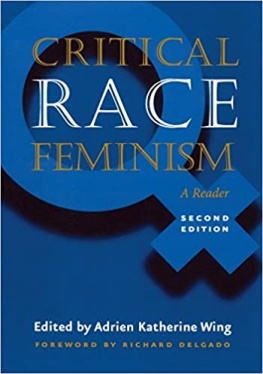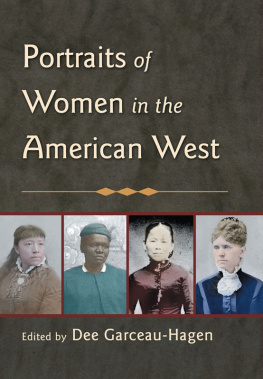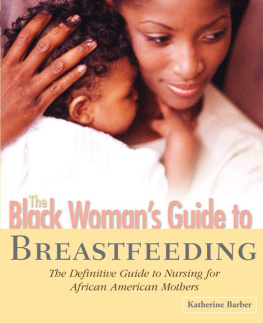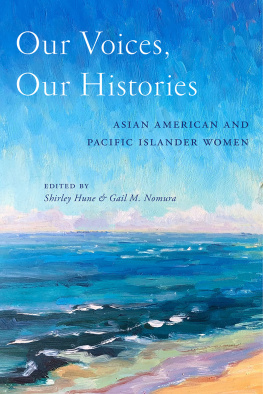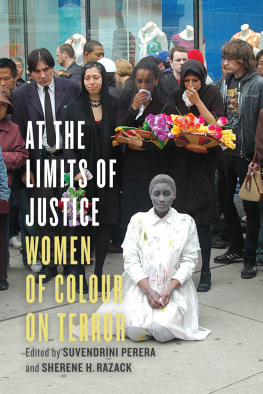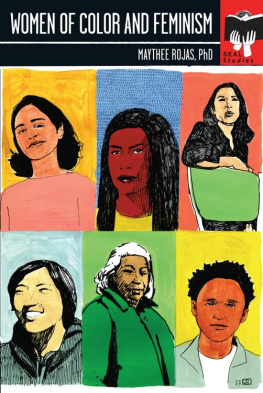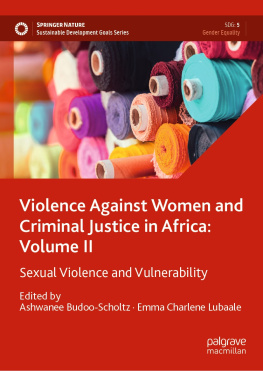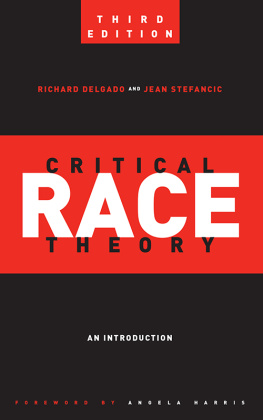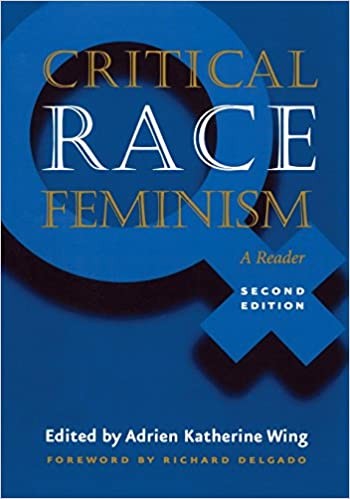Critical Race Feminism
A Reader
Second Edition
Edited by Adrien Katherine Wing
Foreword to Second Edition by Richard Delgado
Foreword to First Edition by Derrick Bell
NEW YORK UNIVERSITY PRESS * New York & London
COPYRIGHT
NEW YORK UNIVERSITY PRESS
New York and London
www.nyupress. Org
Copyright 2003 by New York University and Adrien Katherine Wing
All rights reserved
Library of Congress Cataloging-in-Publication Data
Critical race feminism : a reader / edited by Adrien Katherine Wing.
--2nd ed. / foreword to second edition by Richard Delgado ; foreword
to first edition by Derrick Bell.
p. cm.--(Critical America)
Includes bibliographical references and index.
ISBN 0-8147-93.93-2 (cloth : alk. paper)
ISBN 0-8147-9394-0 (pbk. : alk. paper)
1. Minority women--Social conditions. 2. Minority women--United States--Social conditions. 3. Sex discrimination against women. 4. Sex discrimination against women--United States. 5. Race discrimination. 6. Race discrimination--United States. 7. Feminism. 8. Feminist theory. I. Wing, Adrien Katherine. II. Series. HQ1154.C75 2003
305.48'8'00973--dc21 2003008960
New York University Press books are printed on acid-free paper, and their binding materials are chosen for strength and durability.
Manufactured in the United States of America
10 98765432
Critical Race Feminism
Critical America General Editors: RICHARD DELGADO and JEAN STEFANCIC
White by Law: The Legal Construction of Race Ian F. Haney Lopez
Cultivating Intelligence: Power, Law, and the Politics of Teaching Louise Harmon and Deborah W. Post
Privilege Revealed: How Invisible Preference Undermines America
Stephanie M. Wildman with Margalynne Armstrong, Adrienne D. Davis, and Trina Grillo
Does the Law Morally Bind the Poor? or What Good's the Constitution When You Can't Afford a Loaf of Bread? R. George Wright
Hybrid: Bisexuals, Multiracials, and Other Misfits under American Law
Ruth Colker
Critical Race Feminism: A Reader Edited by Adrien Katherine Wing
Immigrants Out! The New Nativism and the Anti-Immigrant Impulse in the United States
Edited by Juan F. Perea
Taxing America Edited by Karen B. Brown and Mary Louise Fellows
Notes of a Racial Caste Baby: Color Blindness and the End of Affirmative Action
Bryan K. Fair
Please Don't Wish Me a Merry Christmas: A Critical History of the Separation of Church and State Stephen M. Feldman
To Be an American: Cultural Pluralism and the Rhetoric of Assimilation
Bill Ong Hing
Negrophobia and Reasonable Racism: The Hidden Costs of Being Black in America
Jody David Armour
Black and Brown in America: The Case for Cooperation Bill Piatt
Black Rage Confronts the Law Paul Harris
Selling Words: Free Speech in a Commercial Culture R. George Wright
iv
The Color of Crime: Racial Hoaxes, White Fear, Black Protectionism, Police Harassment, and Other Macroaggressions Katheryn K. Russell
The Smart Culture: Society, Intelligence, and Law Robert L. Hayman, Jr.
Was Blind, but Now I See: White Race Consciousness and the Law Barbara J. Flagg
The Gender Line: Men, Women, and the Law Nancy Levit
Heretics in the Temple: Americans Who Reject the Nation's Legal Faith David Ray Papke
The Empire Strikes Back: Outsiders and the Struggle over Legal Education
Arthur Austin
Interracial Justice: Conflict and Reconciliation in Post-Civil Rights America
Eric K. Yamamoto
Black Men on Race, Gender, and Sexuality: A Critical Reader Edited by Devon Carbado
When Sorry Isn't Enough: The Controversy over Apologies and Reparations for Human Injustice Edited by Roy L. Brooks
Disoriented: Asian Americans, Law, and the Nation State Robert S. Chang
Rape and the Culture of the Courtroom Andrew E. Taslitz
The Passions of Law Edited by Susan A. Bandes
Global Critical Race Feminism: An International Reader Edited by Adrien Katherine Wing
Law and Religion: Critical Essays Edited by Stephen M. Feldman
Changing Race: Latinos, the Census, and the History of Ethnicity Clara E. Rodriguez
From the Ground Up: Environmental Racism and the Rise of the Environmental Justice Movement Luke Cole and Sheila Foster
Nothing but the Truth: Why Trial Lawyers Don't, Can't, and Shouldn't Have to Tell the Whole Truth Steven Lubet
v
Critical Race Theory: An Introduction Richard Delgado and Jean Stefancic
Playing It Safe: How the Supreme Court Sidesteps Hard Cases Lisa A. Kloppenberg
Why Lawsuits Are Good for America: Disciplined Democracy, Big Business, and the Common Law Carl T. Bogus
How the Left Can Win Arguments and Influence People: A Tactical Manual for
Pragmatic Progressives John K. Wilson Aftermath:
The Clinton Impeachment and the Presidency in the Age of Political Spectacle Edited by Leonard V. Kaplan and Beverly I. Moran Getting over Equality:
A Critical Diagnosis of Religious Freedom in America Steven D. Smith
Critical Race Narratives: A Study of Race, Rhetoric, and Injury Carl Gutirrez-Jones
Social Scientists for Social Justice: Making the Case against Segregation John P. Jackson, Jr.
Victims in the War on Crime: The Use and Abuse of Victims' Rights Markus Dirk Dubber Original Sin:
Clarence Thomas and the Failure of the Constitutional Conservatives Samuel A. Marcosson
Policing Hatred: Law Enforcement, Civil Rights, and Hate Crime Jeannine Bell
Destructive Messages: How Hate Speech Paves the Way for Harmful Social Movements
Alexander Tsesis
Moral Imperialism: A Critical Anthology Edited by Berta Esperanza Hernndez-Truyol
In the Silicon Valley of Dreams: Environmental Injustice, Immigrant Workers, and the High-Tech Global Economy David N. Pellow and Lisa Sun-Hee Park
Mixed Race America and the Law: A Reader Kevin R. Johnson
Critical Race Feminism: A Reader, Second Edition Edited by Adrien Katherine Wing
vi
Contents
vii
[BLANK PAGE]
Foreword to the Second Edition by Richard Delgado
At one point in my long and checkered career, I taught at a law school whose faculty contained few women of color. In fact, they were in a very small minority--zero. The faculty roster included many women, nine that I can remember, but every one of them was white. It also included many men of color--specifically, seven out of twenty-three. But not one woman of color.
When the glaring absence of black, Latina, and Asian women in a faculty serving a student body that included many women of color--indeed, more than men--dawned on me, I struggled to figure out what it all might mean. Was it just a glitch, one of those anomalies that look peculiar but fall perfectly, as they say, within the range of error? Dusting off my old statistics lore, I made a quick calculation. Assuming that the population of women teaching candidates is about three-fourths white and one-fourth of color, then a law school that set out to hire a single woman professor would--if bias were not a factor--select a white woman about three-fourths of the time. But suppose it set out to hire two. The odds of selecting two Euro-American women in a row would be about nine-sixteenths. So on for each successively longer sequence of hires, so that by the time you get to nine in a row, the chances that all of them would be white are very low indeed.
So, something must be going on. But what? Not conscious discrimination, I reasoned; otherwise the men on the faculty would not be so diverse. Might cognitive theory and unconscious discrimination supply the explanation? Women on the faculty (maybe the men, too) were relying on old-girl networks, recommending friends from school or clerkships or people they knew from conferences or panel sessions. People like them, women with whom they could converse and who knew and understood their jokes, histories, and struggles. White women. Preference for the familiar, the known, the safe, the comfortable. No one set out consciously to hire nine white women professors in a row. It just happened.

